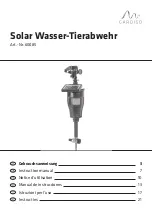
Chapter 2
Digital I/O
© National Instruments Corporation
2-5
Trigger Inputs
Trigger inputs are available from both TTL inputs and isolated inputs. You
can use these trigger inputs to synchronize the NI 8254R with an external
event, such as the assertion of a signal generated by a proximity sensor or
a PLC, to indicate that an inspection item is passing in front of the camera.
The NI 8254R uses this input to initiate a timed pulse that can be used for
camera control, lighting control, encoder pulse counting, and result output
timing.
For more information about creating a timed pulse output, refer to the
Timed Pulse Output section.
TTL Input 0, TTL Input 1, TRIG 0, ISO Input 6, ISO Input 7, ISO Input 8,
and ISO Input 11 can alternatively function as general-purpose inputs.
ISO Input 5 can alternatively function as a latch for the product selection
port.
Timed Pulse Output
The NI 8254R is capable of timed pulse output on six different digital
outputs, which provides precise control over time-critical signals, such as
camera exposure. This section describes the various uses for the timed
pulse output and the parameters you can set to control these outputs.
Uses for timed pulse output include controlling camera reset and exposure,
controlling strobe lighting, operating plungers on an assembly line, and
communicating with PLCs. You can configure the start of the pulse output
generation to occur from software or from a rising or falling edge of a
trigger input.
In addition to controlling the timing of pulse output, you can also configure
the polarity of the output signal, resulting in a high-true or low-true signal.
Based on the polarity setting, the output signal asserts after the appropriate
delay time and de-asserts after the configured pulse width. You can set the
delay time in microseconds or in quadrature encoder counts from the start
signal—either a hardware trigger or a software command. Width is always
configured in microseconds.
Initiating a Timed Pulse
Each timed pulse generator has a trigger input that specifies whether to wait
on a particular trigger input to generate the pulse or to immediately
generate the pulse when software sets the pulse mode to Start in LabVIEW
or imaqIOPulseStart in C and Visual Basic.
















































